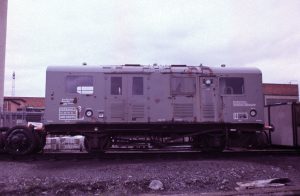Steam Heat Generators - Diesel and Electric Locomotives - top page
Class 31 - SHG removals prior to 12/82
A Plate Wagon and Two Boilers
The story of the Eastern Region's mobile train heating vans by Mark Chaplin
This article first appeared in the January 2022 edition of The Railway Observer (page 42)

Eastern Region Mobile Train Heating Van ADE321075 at Thornaby on 12th March 1988. Photographer Terry Bye
Older members who visited Kings Cross may remember a little four-wheeled van occasionally standing at the platform 5 buffer stops. But most would have passed by without noting its number. I grew up in Cambridge, and remember similar vans in the old Cambridge carriage sidings, between the long through platform and the goods lines, but never recorded any details. I regret that now, because those vans have an interesting but poorly documented history.
The story begins in the famously cold 1962-63 winter, the first with no remaining steam locomotives in East Anglia, and the last with significant steam locomotive haulage of passenger trains at Kings Cross. One of the difficulties of the 1962-63 winter was cold trains because intensive usage of diesel locomotives resulted in them only being attached to passenger trains shortly before departure. This was exacerbated by the unreliability of diesel locomotive train heating boilers. A temporary solution for the 1963-64 winter was to use class B1 steam locomotives as stationary boilers to pre heat trains in carriage sidings. The locomotives used for this purpose are well documented, here it is sufficient to say that various sources mention that they were replaced by mobile heating vans, but without giving details.
Research in the National Archives reveals that the Eastern Region ordered eight mobile heating vans in November 1964, to replace the steam locomotives, and a coal fired stationary boiler at Harwich Parkeston Quay. The vans were designed by the Eastern Region Chief Mechanical and Electrical Engineers Department (CMEE) and consisted of two Spanner Mk.1 boilers and associated control equipment, diesel generator, fuel and water tanks all mounted on an LNER plate wagon underframe. Delivery was due in September 1965 in time for the 1965-66 winter. The ER CMEE 1965 annual report reveals that the vans were constructed at Cowlairs Works with the first delivery on 26th November 1965. Further deliveries were anticipated at approximately weekly intervals and the order had been increased to nine vans to provide a spare. The late delivery explains why many of the steam locomotives lasted through the 1965-66 winter.
The original order of eight vans is believed to be those numbered D321071-78, later ADE321071-78; these start to appear in departmental stock lists in the early 1970s, though with the build date recorded as 1966 not 1965. However, it is still unclear whether the ninth van was actually built and, if so, what number it carried.
The ER CMEE 1965 annual report set out a plan for vans at Parkeston Quay, Ipswich, Norwich, Kings Lynn, Cleethorpes and Sheffield, with two at Cambridge and one spare. The first known record is DE320174 arriving at Stratford DRS for repairs on 2nd May 1968 and the first report in The Railway Observer is of DE321072 at Cleethorpes on 22nd February 1969, in the April 1969 issue. In addition to visits to Stratford some repairs also took place at Doncaster Works. By the early 1980s all of ADE321071-78 were in East Anglia, except for ADE321072. This was at Finsbury Park until closure, then Bounds Green, and was the van used occasionally at Kings Cross to provide 'shore supply' when the stationary boiler there was out of action.
An incident with ADE321072 points to he source of the Spanner Mk.1 boilers used in the mobile heating vans. In the original proposal these were costed at scrap value of £20 each, so clearly were not new boilers. During the 1980-81 winter one of the boilers in ADE321072 overheated after a switch failed, and had to be replaced. ADE 321072 was moved to Stratford DRS on 9th February 1981 where it received the boiler removed from locomotive 31240.
This suggests that the Spanner Mk.1 boilers used when the vans were constructed also came from Brush Type 2 locomotives. The locomotives that donated the boilers are thought to be D5538/42/83, D5804-8/10/1/3/5/6/9-22/9/34/6/9. These 21 locomotives are listed in Diesel Dilemmas on the RCTS website as having lost their boilers before February 1969. The boiler removals are now thought to have taken place at Doncaster Works in the spring of 1965, when all 21 locomotives were allocated to Wath, a depot where almost all of the booked Brush Type 2 work did not require steam heat. Eight vans require sixteen boilers and nine vans require eighteen boilers so it is not clear why the number of boilers removed was 21, or what happened to the surplus.
These mobile heating vans defy categorisation: they have boilers from locomotives, but are not locomotives; they look like carriages, but are not carriages and they are built on wagon underframes, but are not wagons. I hope this article might prompt readers to provide more information that helps to fill the remaining gaps in this unusual story.
Mark Chaplin
Footnote.
Please contact Peter Hall if you have any further details regarding these heating vans or the re-use of boilers removed from the locomotives mentioned. It has not yet been established the type of boiler used in ER Train Heating Van DE75415 (Was this the ninth, spare, mentioned in the article?) and NER Train Heating Instruction Vans DE321099 - DE321101. Please make contact if you know the answer or have any further details about these vans.
This page is maintained by Peter Hall.
